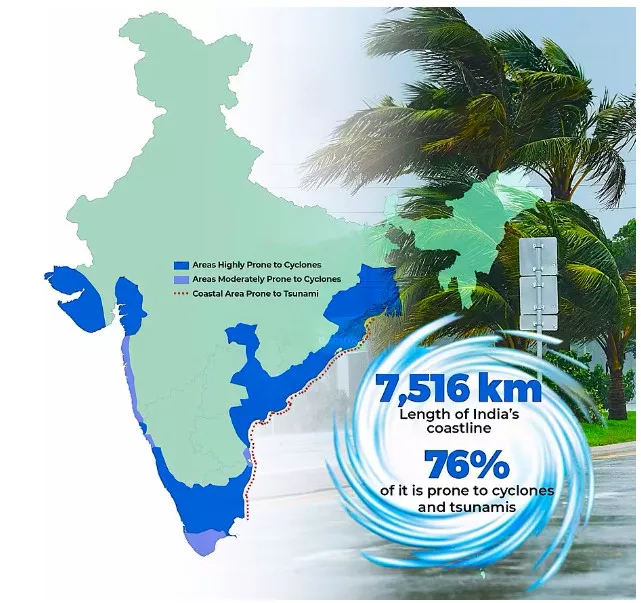Core Demand of the Question
- How India has managed to save the loss of lives.
- Roadblocks in securing livelihoods.
|
Answer
Introduction
Cyclone Montha (October 2025) showed India’s improved disaster preparedness, with relatively fewer casualties due to early warnings and evacuations. However, recurring livelihood losses among farmers, fishers, and workers reveal that disaster management still prioritises saving lives over securing livelihoods.
Body
How India Has Managed to Save Lives During Cyclones
- Improved Early Warning Systems: The India Meteorological Department (IMD) provides timely, accurate forecasts, enabling proactive evacuation and preparedness.
- Effective Shelter Management: States have developed robust evacuation protocols and cyclone shelters to minimise human casualties.
Eg: Over 1,000 multi-purpose cyclone shelters were developed by Odisha State Disaster Management Authority (OSDMA) in various districts to take people to safety during cyclones
- Institutional Coordination through NDMA and NDRF: The National Disaster Management Authority (NDMA) and National Disaster Response Force (NDRF) ensure coordinated response and relief operations.
- Community-Based Disaster Preparedness: Local volunteer networks and women-led self-help groups play a key role in awareness and response.
- Technological Integration and Communication Infrastructure: Use of GIS, satellite tracking, and mobile alerts enhances real-time communication.
Eg: The Common Alerting Protocol and SACHET App of NDMA disseminate multi-hazard alerts directly to citizens.

Fig: India’s Cyclone Corridor
|
Roadblocks in Securing Livelihoods During Cyclones
- Destruction of Productive Assets: Agriculture, fisheries, and livestock face massive losses, crippling household incomes post-disaster.
- Inadequate Insurance and Financial Support: Crop and livestock insurance penetration remains low, with delayed or partial compensation.
- Weak Infrastructure and Connectivity: Cyclones damage roads, power supply, and communication, hampering relief delivery and market access.
- Limited Rehabilitation for Informal Workers: Daily wage earners and small traders lack formal protection or social safety nets.
Eg: Post-Cyclone Phailin (2013), informal workers in Ganjam district faced prolonged unemployment due to absence of livelihood restoration schemes.
- Environmental Degradation and Recurrent Vulnerability: Repeated cyclones erode soil fertility, destroy mangroves, and reduce ecosystem resilience.
Eg: Mangrove loss in Odisha’s coastal belt after Cyclone Fani (2019) reduced natural protection and fish productivity.
Conclusion
India’s disaster management progress has turned cyclones from fatal events into manageable crises through IMD forecasting, NDRF action, and NDMA coordination. Ensuring livelihood security now needs climate-resilient infrastructure, wider insurance, and livelihood restoration under PM Matsya Sampada Yojana and NCRMP for sustainable coastal resilience.
To get PDF version, Please click on "Print PDF" button.


Latest Comments